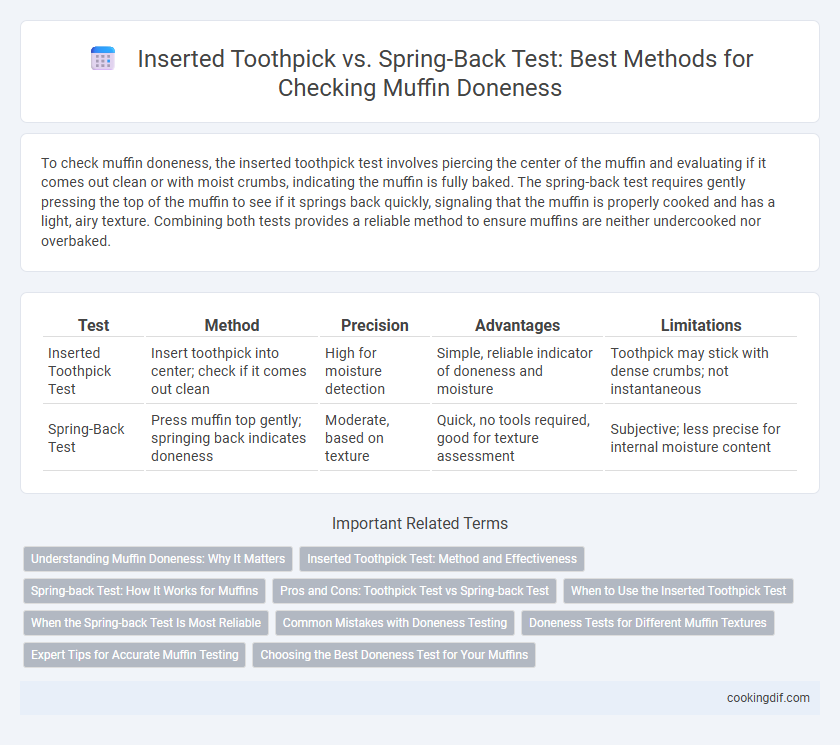To check muffin doneness, the inserted toothpick test involves piercing the center of the muffin and evaluating if it comes out clean or with moist crumbs, indicating the muffin is fully baked. The spring-back test requires gently pressing the top of the muffin to see if it springs back quickly, signaling that the muffin is properly cooked and has a light, airy texture. Combining both tests provides a reliable method to ensure muffins are neither undercooked nor overbaked.
Table of Comparison
| Test | Method | Precision | Advantages | Limitations |
|---|---|---|---|---|
| Inserted Toothpick Test | Insert toothpick into center; check if it comes out clean | High for moisture detection | Simple, reliable indicator of doneness and moisture | Toothpick may stick with dense crumbs; not instantaneous |
| Spring-Back Test | Press muffin top gently; springing back indicates doneness | Moderate, based on texture | Quick, no tools required, good for texture assessment | Subjective; less precise for internal moisture content |
Understanding Muffin Doneness: Why It Matters
Inserted toothpick and spring-back tests are critical methods for assessing muffin doneness, ensuring the interior is fully baked without excess moisture. The toothpick test detects wet batter by inserting it into the center, while the spring-back test evaluates muffin elasticity by gently pressing the surface. Proper application of these tests prevents underbaking, preserves texture, and guarantees a tender, moist crumb in every muffin.
Inserted Toothpick Test: Method and Effectiveness
The inserted toothpick test for muffin doneness involves piercing the center of the muffin with a clean toothpick and checking for moist batter clinging to it; a clean or nearly clean toothpick indicates the muffin is fully baked. This method is highly effective due to its simplicity and direct assessment of the internal texture without relying on external appearance. Compared to the spring-back test, the toothpick test provides a more objective measure of doneness, reducing the risk of underbaking or overbaking muffins.
Spring-back Test: How It Works for Muffins
The spring-back test for muffins involves gently pressing the muffin's top surface to check if it springs back, indicating proper doneness and a moist interior. Unlike the inserted toothpick method, which requires breaking the muffin to verify if batter sticks, the spring-back test offers a non-invasive way to assess texture and baking completion. This technique helps bakers avoid overbaking while ensuring muffins have the ideal crumb and tenderness.
Pros and Cons: Toothpick Test vs Spring-back Test
The inserted toothpick test for muffin doneness offers a straightforward method by checking for moist crumbs on the toothpick, ensuring thorough baking but sometimes leaving slight ambiguity with sticky crumbs. The spring-back test provides immediate tactile feedback by gently pressing the muffin's surface to detect resilience, which helps avoid overbaking but can be subjective and varies with recipe moisture content. Combining both tests can improve accuracy, balancing visual confirmation with textural assessment for perfect muffin readiness.
When to Use the Inserted Toothpick Test
The inserted toothpick test is ideal for determining muffin doneness when the batter contains added moisture or mix-ins like fruits or nuts, which can make visual cues unreliable. This method involves inserting a clean toothpick into the center of the muffin; if it comes out clean or with just a few crumbs, the muffin is fully baked. Use this test especially for dense or moist muffins where the spring-back test might give misleading results due to surface elasticity.
When the Spring-back Test Is Most Reliable
The spring-back test for muffin doneness is most reliable when the muffin has had adequate baking time to develop a stable crumb structure, typically after 18-22 minutes at 375degF (190degC). This test accurately indicates that the interior has set if the muffin springs back gently when pressed, signaling moisture retention without undercooking. In contrast to the inserted toothpick test, which checks for raw batter residue, the spring-back test better reflects texture readiness and overall muffin quality at optimal baking stages.
Common Mistakes with Doneness Testing
Common mistakes in doneness testing of muffins include relying solely on the inserted toothpick method, which can produce misleading results if crumbs stick to the toothpick or if it is inserted too close to the edge where the muffin cooks faster. The spring-back test, which checks the muffin's surface firmness by gently pressing, often provides a more reliable indicator of doneness, avoiding uneven cooking issues. Overlooking these nuances can lead to underbaked or dry muffins, affecting texture and taste.
Doneness Tests for Different Muffin Textures
Inserted toothpick and spring-back tests are common methods to assess muffin doneness, each suited for distinct textures. The inserted toothpick test works best for denser muffins like bran or blueberry, as a clean toothpick indicates complete baking without excess moisture. The spring-back test is ideal for lighter, airier muffins such as plain or lemon poppy seed, confirming doneness when the muffin springs back quickly to gentle pressure.
Expert Tips for Accurate Muffin Testing
For expert muffin doneness testing, the inserted toothpick method provides precise results by identifying moist crumbs or batter on the probe, signaling underbaking. The spring-back test assesses surface resilience by gently pressing the muffin top, ensuring the structure springs back without indentations, indicating proper cooking. Combining both tests enhances accuracy by confirming internal and external muffin readiness, essential for optimal texture and flavor.
Choosing the Best Doneness Test for Your Muffins
Choosing the best doneness test for your muffins depends on texture preference and baking precision. The inserted toothpick test identifies moisture by checking for crumbs or wet batter, ensuring muffins are fully baked without dryness. The spring-back test evaluates firmness by gently pressing the muffin top, indicating doneness through resilience and softness, ideal for those who prefer slightly moist interiors.
Inserted toothpick vs Spring-back test for doneness Infographic

 cookingdif.com
cookingdif.com